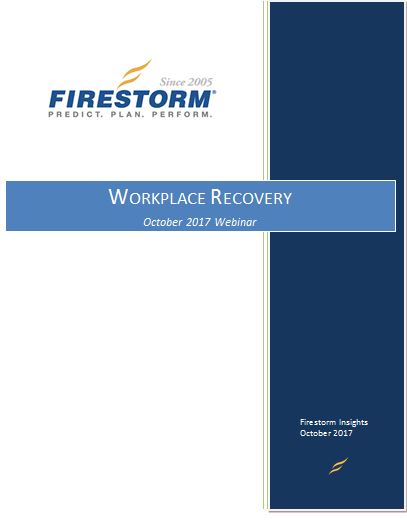Finding a Place to Work Following a Natural Disaster
Planning for disasters can make a significant difference when your organization is struck by a crisis. Organizations often focus on brand image, violence issues or  cyber crises and forget about natural disaster planning. Natural disasters can cause fatalities and reputation damages. Firestorm recently conducted a survey and asked business participants what crisis event would be the number one concern for their organization; 24 percent indicated natural disaster devastation.
cyber crises and forget about natural disaster planning. Natural disasters can cause fatalities and reputation damages. Firestorm recently conducted a survey and asked business participants what crisis event would be the number one concern for their organization; 24 percent indicated natural disaster devastation.
Ask yourself the question: how robust is your business continuity strategy? More important, has your business continuity strategy been tested? Take a moment to think about the impact natural disasters have had on organizations exactly like yours; whether the event be a hurricane, the fires in California or the September 2017 earthquake in Mexico. When a disaster strikes, could your business continue operations? How quickly could your organization return to business? These are questions you must ask yourself before a natural disaster strikes.
Harvey, Imra, Maria, Nate – What’s next?
Hurricanes Harvey, Irma, Maria and Nate proved to be costly storms. Initial estimates from insurance companies like Hannover Re put the cost at $3 billion for Hurricane Harvey alone. In a note to clients, JP Morgan estimated that the insurance industry could lose $10 to $20 billion from Harvey, making it one of the top 10 costliest hurricanes to hit the U.S. Estimates for Harvey damages to-date have exceeded $30 billion. In addition to impacts to your business, employees and suppliers are affected simultaneously. Today, the largest single failure in a disaster or a crisis is supply chain failure. Although your organization may not have been directly affected by hurricanes this year, you may have suppliers who are headquartered or run through cities like that were directly hit.
In the October 2017 webinar, Firestorm President, CEO and Co-Founder, Jim Satterfield, discussed how to continue business operations if your organization is struck by a natural disaster. Jim was joined by Firestorm COO, Hart Brown, and Regus Global Solutions Director, Dan Perrin.
When planning for disaster, an organization must discuss alternative work sites and remote working.
Alternate Work Options
Alternative worksites must be dynamic and established. A dynamic recovery site provides employees multiple locations to work from; for example, a Regus location or a national hotel chain. The recovery site(s) should not be next to the primary location or across the street. If a worksite is destroyed or damaged during a natural disaster, the neighboring building may be as well. Ensure the recovery worksites are equipped with a secure internet connection. Train your employees to avoid using open internet connections – even if working from home – to mitigate cyber breach exposure.
Is Remote Working Feasible?
- Would your organization be able to continue its core operations remotely (home)?
- If so, are there any special requirements?
- What is the impact from a loss of utilities and communications capabilities for an extended period of time?
- Have solutions been tested?
- Keep in mind issues that may arise including: employees unable to return home and loss of structure or power.
What are your organizations’ disaster checklists? Download the full Firestorm brief to view checklist examples that will provide an idea of factors to consider when creating a business disaster recovery plan.
Watch a recording of the webinar session via the Firestorm YouTube page.
 “What should we do now?” “What should we say?”
“What should we do now?” “What should we say?”